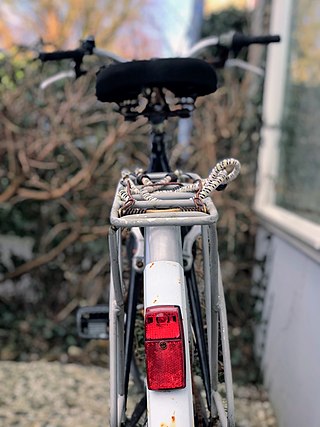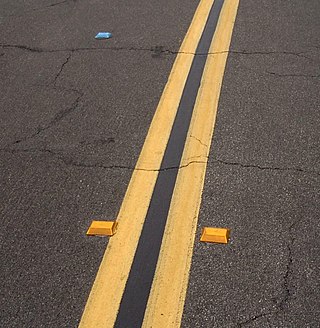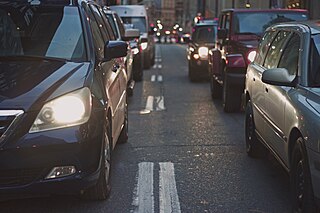
A corner reflector is a retroreflector consisting of three mutually perpendicular, intersecting flat surfaces, which reflects waves directly towards the source, but translated. The three intersecting surfaces often have square shapes. Radar corner reflectors made of metal are used to reflect radio waves from radar sets. Optical corner reflectors, called corner cubes or cube corners, made of three-sided glass prisms, are used in surveying and laser ranging.

A retroreflector is a device or surface that reflects radiation back to its source with minimum scattering. This works at a wide range of angle of incidence, unlike a planar mirror, which does this only if the mirror is exactly perpendicular to the wave front, having a zero angle of incidence. Being directed, the retroflector's reflection is brighter than that of a diffuse reflector. Corner reflectors and cat's eye reflectors are the most used kinds.

High-visibility clothing, sometimes shortened to hi vis or hi viz, is any clothing worn that is highly luminescent in its natural matt property or a color that is easily discernible from any background. It is most commonly worn on the torso and arm area of the body. Health and safety regulations often require the use of high visibility clothing as it is a form of personal protective equipment. Many colors of high visibility vests are available, with yellow and orange being the most common examples. Colors other than yellow or orange may not provide adequate luminescence for conformity to standards such as ISO 20471.

A headlamp is a lamp attached to the front of a vehicle to illuminate the road ahead. Headlamps are also often called headlights, but in the most precise usage, headlamp is the term for the device itself and headlight is the term for the beam of light produced and distributed by the device.

Bicycle lighting is illumination attached to bicycles whose purpose above all is, along with reflectors, to improve the visibility of the bicycle and its rider to other road users under circumstances of poor ambient illumination. A secondary purpose is to illuminate reflective materials such as cat's eyes and traffic signs. A third purpose may be to illuminate the roadway so that the rider can see the way ahead. Serving the latter purposes require much more luminous flux and thus more power.

Bicycle law in California is the parts of the California Vehicle Code that set out the law for persons cycling in California, and a subset of bicycle law in the United States. In general, pretty much all the same rights and responsibilities that apply to car drivers apply to bicycle riders as well.

A raised pavement marker is a safety device used on roads. These devices are usually made with plastic, ceramic, thermoplastic paint, glass or occasionally metal, and come in a variety of shapes and colors. Raised reflective markers, such as plastic, ceramic, or metal ones, include a lens or sheeting that enhances their visibility by retroreflecting automotive headlights, while glass road studs gather automotive headlights with a dome shape and reflect the lights with a reflective layer within. Some other names for specific types of raised pavement markers include convex vibration lines, Botts' dots, delineators, cat's eyes, road studs, or road turtles. Sometimes they are simply referred to as "reflectors".

A rear-view mirror is a, usually flat, mirror in automobiles and other vehicles, designed to allow the driver to see rearward through the vehicle's rear window.

A daytime running lamp is an automotive lighting and bicycle lighting device on the front of a roadgoing motor vehicle or bicycle, automatically switched on when the vehicle's handbrake has been pulled down, when the vehicle is in gear, or when the engine is started, emitting white, yellow, or amber light. Their intended use is not to help the driver see the road or their surroundings, but to help other road users identify an active vehicle.

A motor vehicle has lighting and signaling devices mounted to or integrated into its front, rear, sides, and, in some cases, top. Various devices have the dual function of illuminating the road ahead for the driver, and making the vehicle visible to others, with indications to them of turning, slowing or stopping, etc., with lights also indicating the size of some large vehicles.
Federal Motor Vehicle Safety Standard 108 regulates all automotive lighting, signalling and reflective devices in the United States. Like all other Federal Motor Vehicle Safety Standards, FMVSS 108 is administered by the United States Department of Transportation's National Highway Traffic Safety Administration.

A motorized bicycle is a bicycle with an attached motor or engine and transmission used either to power the vehicle unassisted, or to assist with pedalling. Since it sometimes retains both pedals and a discrete connected drive for rider-powered propulsion, the motorized bicycle is in technical terms a true bicycle, albeit a power-assisted one. Typically they are incapable of speeds above 52 km/h (32 mph), however in recent years larger motors have been built, allowing bikes to reach speeds of upwards of 72 km/h.
Many countries have enacted electric vehicle laws to regulate the use of electric bicycles, also termed e-bikes. Some jurisdictions have regulations governing safety requirements and standards of manufacture. The members of the European Union and other regions have wider-ranging legislation covering use and safety.

A motorized scooter is a stand-up scooter powered by either a small internal combustion engine or electric hub motor in its front and/or rear wheel. Classified as a form of micro-mobility, they are generally designed with a large center deck on which the rider stands. The first motorized scooter was manufactured by Autoped in 1915.

A side-view mirror, also known as a wing mirror, is a mirror placed on the exterior of motor vehicles for the purposes of helping the driver see areas behind and to the sides of the vehicle, outside the driver's peripheral vision.
Vehicle regulations are requirements that automobiles must satisfy in order to be approved for sale or use in a particular country or region. They are usually mandated by legislation, and administered by a government body. The regulations concern aspects such as lighting, controls, crashworthiness, environment protection and theft protection, and might include safety belts or automated features.
Government regulation in the automotive industry directly affects the way cars look, how their components are designed, the safety features that are included, and the overall performance of any given vehicle. As a result, these regulations also have a significant effect on the automotive business by generally increasing production costs while also placing limitations on how cars are sold and marketed. Automotive regulations are designed to benefit the consumer and protect the environment, and automakers can face stiff fines and other penalties if they are not followed.
Retroglo is a reflective yarn designed to increase nighttime safety. It is made of 3M Scotchlite Reflective Material and laminated to a polyester film for added strength. Retroglo is used for a wide variety of applications including high-visibility clothing for joggers, walkers, bicycle riders, and highway workers.

In the United Kingdom, lighting-up time is a legally-enforced period from half an hour after sunset to half an hour before sunrise, during which all motor vehicles on unlit public roads must use their headlights.
A slow moving vehicle is a vehicle or caravan of vehicles operated on a street or highway at speeds slower than that of other motorized traffic.

Road signs in France refer to all conventional signals installed on French roads and intended to ensure the safety of road users, either by informing them of the dangers and regulations relating to traffic as well as elements useful for decision-making, or by indicating to them the landmarks and equipment useful for their travel on the national territory. They generally largely follow the general European conventions concerning the use of shape and color to indicate their function. France is a signatory to the 1968 Vienna Convention on Road Signs and Signals. France signed the Vienna Convention on Road Signs and Signals on November 8, 1968 and ratified it on December 9, 1971.





















